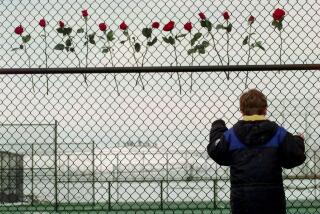Columbine stays with him
- Share via
It was supposed to be just another day in high school. Prom was over. The spring play had wrapped. No sporting events were scheduled. Only a couple of weeks stood between student Andrew Robinson and summer vacation.
Then, in an instant, that carefree Tuesday at Colorado’s Columbine High School turned violent.
Robinson, then 17, was initially oblivious as Eric Harris and Dylan Klebold began to fire their weapons. The sound of gunshots was muffled by the concrete walls of the computer lab where he was studying. And the fire alarm didn’t cause him panic. He figured it was simply a drill or a senior prank. But when he walked out to the hallway, he knew something was horribly wrong.
“There’s a big difference between the way a person looks when they’re running track and field and the way people look when they’re running for their lives,” said Robinson, a self-proclaimed “terrible” student. “I’ve never seen anything like that. Until that day.”
Robinson survived the shooting rampage on April 20, 1999, that left 15 people dead, including the shooters, and injured 24 others.
A decade later, he’s written and directed “April Showers,” a dramatized retelling of what it’s like to be a survivor of one of the nation’s deadliest school shootings.
The movie, which features Tom Arnold (“True Lies”) and Daryl Sabara (“Spy Kids”), is set to be released in selected theaters around the nation on April 24, when it will play five times a day during a one-week run, in commemoration of the 10th anniversary of the Columbine tragedy. The film is not scheduled to play in Los Angeles theaters, but it will be available for downloading beginning May 5 on iTunes and for streaming at IndieFlix.com with a portion of every download being donated to charity.
The filmmaker’s portion of all first-week proceeds from theatrical screenings will be donated to local schools.
Jenna Edwards, producer of the film, said she hoped that the R-rating by the Motion Picture Assn. of America for “some disturbing content” doesn’t deter viewers from seeing the film.
“The message I want audiences to take away is to not take anything for granted,” Robinson added. “When you’re young, you think that you are indestructible; you think that nothing bad is going to happen to you. When it does, you realize that there are quite a few instances in your life that you didn’t get to play out. You have to kind of grapple with that feeling of regret.”
Robinson’s film isn’t the first cinematic dramatization of a school shooting post-Columbine. In 2003’s “Elephant,” writer-director Gus Van Sant chronicled the events surrounding a massive school shooting. Ben Coccio’s “Zero Day” (2003) looks at the planning stages of two students that lead up to their shooting rampage at school. “Home Room” (2002) is a story that deals with the aftermath of a high school shooting and the unlikely friendship of two survivors. But “April Showers” isn’t like the others, Robinson said.
“I didn’t want to focus on the gunmen or the actual shooting,” Robinson said. “What is more important is what do we do now? You know, these neighborhoods get turned upside down. These lives get turned upside down. We kind of almost became strangers in our own land.”
The movie, filmed in Omaha and Plattsmouth, Neb., follows the lives of a handful of survivors in a middle-class suburban neighborhood as they deal with issues that Robinson said weren’t addressed by the media, such as post-traumatic stress disorder and sensational media coverage.
“The media trucks just sort of descended upon everyone,” Robinson said. “And the camera lenses became similar to guns in a way. Out to get us. It made it hard for some people to get closure.”
Robinson eventually moved to Southern California to study advertising and film at the Art Center College of Design in Pasadena. He worked as art director for various entertainment design firms before leaving to devote his time to “April Showers,” his second writing-directing effort, once he secured investors in the project.
It’s a project he’s hoping young people will see. Shedding light on the issues students struggled with afterward -- faith, mortality, regret -- is something that he believes needs more awareness.
“The idea of ‘out of sight, out of mind’ is asinine,” Robinson said. “You’re taking away students’ ability to face what may be ailing them. We need to allow them to face it. Hopefully this film will make others realize that.”
--
More to Read
The biggest entertainment stories
Get our big stories about Hollywood, film, television, music, arts, culture and more right in your inbox as soon as they publish.
You may occasionally receive promotional content from the Los Angeles Times.











